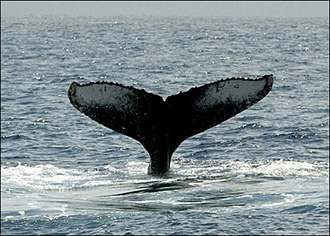 |
 |
 |
 Editorials | Environmental | September 2007 Editorials | Environmental | September 2007  
US Judge Overturns Whale-Protecting Ban on Sonar
 Agence France-Presse Agence France-Presse
go to original


| | Tail of a humpback whale. An appeals court overturned a ban on the US navy's use of sonar in upcoming training exercises off California that was aimed at protecting whales disturbed by the subsea emissions. (AFP/Rodrigo Buendia) |
Washington - An appeals court overturned Friday a ban on the US navy's use of sonar in upcoming training exercises off California that was aimed at protecting whales disturbed by the subsea emissions.

Reversing an August 6 decision in the longstanding battle between environmental groups and the US military over whale safety, the appeals court said the court that handled the case earlier had overstepped.

It said that court had not adequately justified its ruling against sonar use in the navy's 14 planned exercises offshore southern California during 2007-2009.

The appeals court added that although the public had an interest in protecting whales, US defense needs must also be considered.

"We are currently engaged in war, in two countries ... The safety of the whales must be weighed, and so must the safety of our warriors. And of our country," Friday's ruling said.

Environmentalists say the sonar - which works by flooding large areas of the ocean with loud bursts of sound - can injure or even kill whales, forcing them to beach themselves on land.

Although litigation brought over war games off the coast of Hawaii resulted in a settlement last year, the navy had refused to take steps to mitigate the impact of the sonar during tests in California waters - like posting people to watch out for whales and tailoring activities to avoid them.

The court criticized the navy for this, but ultimately said the groups fighting to protect the whales had not substantiated their case of irreversible damage to whales and to the environment from the use of sonar.

"The district court did not explain why a broad, absolute injunction against the use of the medium frequency active sonar in the complex training exercises for two years was necessary to avoid irreparable harm to the environment," the appeals court said.
Judge OKs Rule That May Endanger Species
Associated Press
go to original

Washington - A federal judge has upheld the government's practice of allowing development to proceed even if it is discover'd after a project begins that the work could endanger protected species.

The National Association of Home Builders praised the ruling Friday, saying its members might have had to delay some projects if U.S. District Judge Emmet G. Sullivan had not agreed with the "no surprises" approach to development.

"The vast majority of endangered species exist on private property, and there is no way to protect endangered species unless sufficient incentives are given to private landowners," said Duane Desiderio, the trade group's vice president for legal affairs.

The case affects a pair of rules which allow landowners and developers to obtain a permit that lets them off the hook for incidentally killing, injuring or harassing rare animals, and damaging or killing rare plants. Development projects must be accompanied by a plan for addressing protections for the natural places where plants and animals live.

But the government reserves the right to revoke a permit if killing a plant or animal makes it more likely the species will go extinct in the wild.

Environmental groups that had sued the government to overturn the two rules expressed disappointment Friday but said they had not yet decided whether to appeal Sullivan's ruling. On Thursday, he found the two rules consistent with federal laws, including the Endangered Species Act.

Sullivan also wrote that "it is appropriate for the court to presume" that the government will protect endangered species, despite issuing 379 permits authorizing the killing of rare plants and animals between 1994 and 2002.

"We're very disappointed," said Leeona Klippstein, executive director of the California-based Spirit of the Sage Council, which represents American Indians and environmentalists. "This means that over 39 million habitat acres will be lost, and over 200 species included in 500 conservation plans will never see recovery."

Later Friday, she noted that in the past two years those numbers have grown to 60 million acres and 458 species included in the 500 conservation plans, based on newly revised government figures.

Katherine Meyer, a lawyer for the firm that represented the groups, said that Congress ought to rewrite the law to strengthen protections for endangered species, especially since two previous U.S. district court rulings had contradicted Sullivan's ruling.

The Fish and Wildlife Service and the National Marine Fisheries Service adopted the "no surprises" policy in August 1994, then cemented it in a pair of rules in 1998 and 1999.

After the council and other groups sued, Sullivan agreed in 2004 to halt them for six months while the agencies gathered more public comment. He found the Clinton administration had not given people enough opportunity to weigh in.

In December 2004, the Bush administration reissued the rules, saying the government must be able to give home builders, timber and mining companies and other developers some immunity against unforeseen twists in providing species protections. | 
 | |
 |



